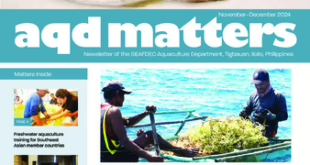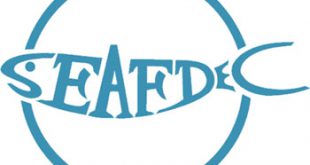| Papaya, malunggay, ipil-ipil and Azolla: must-haves for abalone? |
| Abalone need green leafy “vegetables,” too |
| Abalone, being herbivores, are known to feed on seaweeds in the wild. However, seaweeds like Graciliariopsis bailinae are economically important in themselves, being sources of valuable agar. Seaweeds just can not be used as feed. Hence, locally available plants may just be the right supplement or replacement for expensive components in formulated feeds for abalone.
In the Philippines, the terrestrial plants Carica papaya, Leucaena leucocephala, Moringa oliefera, locally known by their less-daunting names papaya, ipil-ipil, and malunggay, respectively, may be the ideal candidates for this purpose. A freshwater fern, Azolla pinnata, is another potential alternative, being incorporated in the diets of tilapia and carp to promote their growth.
A study conducted by SEAFDEC/AQD’s Ofelia Reyes and Armando Fermin tests this idea. About 13% of the total 27% crude protein of formulated diets come from the plant meals. The formulated diets were fed daily to juvenile abalones stocked in fifteen 60-liter fiberglass tanks at 2-3% of their body weights, while the control feed consisting of fresh Graciliariopsis bailinae was given daily at 30% of the total body weight.
After 120 days, the results were in: specific growth rates of abalone fed M. oliefera and A. pinnata were significantly higher than those fed L. leucocephala, but not to those fed fresh G. bailinae. In terms of weight, diets based on M. olifiera, A. pinnata and fresh G. bailinae showed greater gains compared with the L. leucocephala-based diet. Abalone fed M. oliefera also had a significantly higher protein productive value (PPV) of 79.9, while the rest had values 57.3 or lower, with that of G. bailinae having the lowest value of only 12.3.
Why the results? The higher growth rate of M. oliefera- and A. pinnata-fed abalone could be due to the physical characteristics of the leaves, having softer textures and less fiber compared to the other leaf meals. M. oliefera is also rich in the minerals calcium, iron and phosphorous, which could have improved the nutritive value of the diet. On the other hand, L. leucocephala contains the anti-nutritional factor mimosine, which could still have been present in the diet. This explains why abalone fed this treatment had the lowest weight and length gains.
Given that one of the main concerns in the culture of abalone is the high cost of feed, it would not hurt if the commonly-found M. oliefera and A. pinnata be used as one of the ingredients of diets for abalone. Not only are they available year-round, they also contain essential nutrients to support the growth of H. asinina.
Read more from the journal Aquaculture Research (2003) 34: 593-599. |
Check Also
2023 Releases
September-October 2023Download here — File Size: 7.85 Mb July-August 2023Download here — File Size: 5.17 …
 SEAFDEC/AQD Southeast Asian Fisheries Development Center | Aquaculture Department
SEAFDEC/AQD Southeast Asian Fisheries Development Center | Aquaculture Department

